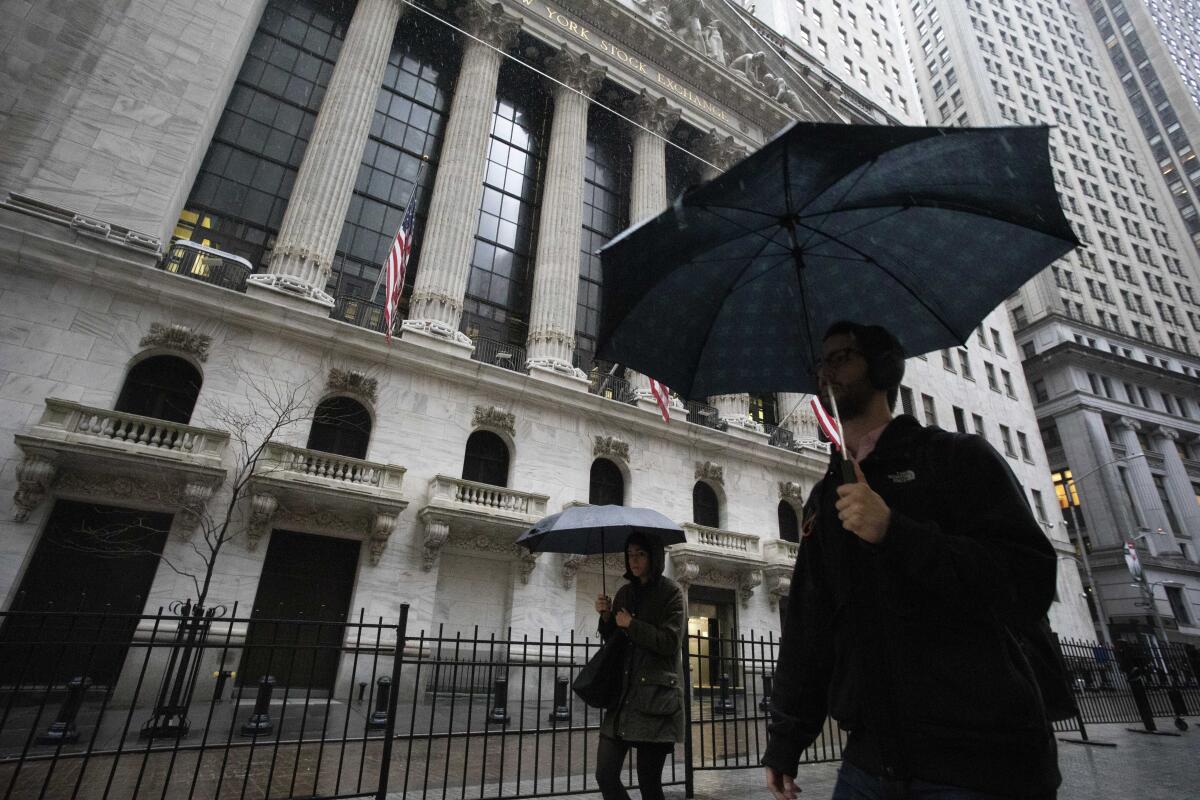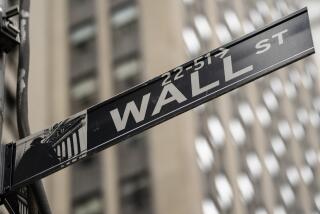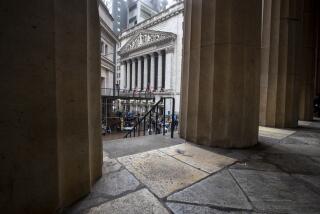Stocks soar 9% after Trump promises resources to fight coronavirus

- Share via
Wall Street roared back from its worst day in 30 years with a broad Friday rally that sent the Dow Jones industrial average nearly 2,000 points higher after President Trump declared the coronavirus pandemic a national emergency.
Fueled by a late-day surge while Trump was speaking, the major indexes each closed with gains of more than 9%. The rally recouped many of the losses from the prior day, when the index experienced its worst slide since the Black Monday crash of 1987.
The session capped a dizzying week on Wall Street, with wild swings driven largely by uncertainty over how much damage the coronavirus would cause to the global economy. By Thursday, the Dow had suffered two drops of more than 2,000 points and the nation’s longest-ever bull market had ended.
Then on Friday, stocks rallied, shooting sharply upward in the last half-hour of trading as investors appeared to gain confidence that the Trump administration is moving to fight the outbreak from both a healthcare and economic perspective.
Despite Friday’s pickup, the market still posted its second-biggest weekly loss in the last 10 years. In just a few weeks, U.S. stocks have lost all the gains made during 2019, one of the best years for the market in decades. All the major indexes are in what traders call a bear market — down more than 20% from the record highs they reached just last month.
Investors have been clamoring for strong action from the U.S. government to fight the outbreak’s effect on businesses and workers. News that the White House and Congress were close to announcing an agreement on a package to provide sick pay, free testing and other resources helped boost the market.
“We’re finally getting that a little late to the party, but it’s better to be late to the party than not to come to the party,” said Ryan Detrick, senior market strategist at LPL Financial. He said the stimulus plan should help cushion the financial effects on people and businesses.
The Standard & Poor’s 500 index jumped 9.3% on Friday, finishing the week with a loss of 14.5%. The Dow soared 1,985 points, or 9.4%. The Nasdaq composite climbed 9.3%.
The yield on the 10-year Treasury climbed to 0.96%.
Stocks jumped in the early going Friday after Treasury Secretary Steven Mnuchin said on CNBC that the two sides were “very close to getting this done.” But during an afternoon White House press conference, Trump said the White House and Congress had yet to agree on a broader aid package. He said he doesn’t believe House Democrats are “giving enough.”
Speaker Nancy Pelosi (D-San Francisco) said the House would approve its own coronavirus aid package and urged the Trump administration and congressional Republicans to “put families first” by backing the effort to provide Americans with relief.
The market’s rout intensified this week amid a torrent of cancellations and shutdowns worldwide. Business closures have fueled fear that a severe pullback in consumer and business spending will tip the U.S. economy into a recession and wreck corporate profits.
The virus has infected more than 137,000 people worldwide. More than 5,000 have died, but half of those who had the virus have already recovered. The pandemic’s new epicenter is Europe. In the United States, confirmed cases have topped 1,600, while 41 people have died, according to the Centers For Disease Control and Prevention.
Friday’s rally was broad, with technology stocks accounting for a big slice of the gains. Shares in cruise line operators, airlines and hotels — among the hardest-hit stocks as people canceled vacations and companies shut down business trips — headed up.
Investors’ anticipation of a government stimulus effort and an interest-rate cut by the Federal Reserve next week likely put traders in a buying mood, though it’s not unusual for stocks to rebound the day after a big decline.
“I don’t know if I would call this a dead-cat bounce, but I would certainly not call it a trend,” said Katie Nixon, chief investment officer at Northern Trust Wealth Management. “Maybe it reflects a little more optimism that we’re getting a fiscal impulse that will help support the economy and, by extension, the market while we get through this transitory period of economic weakness.”
On Thursday, the Federal Reserve unveiled a massive short-term lending program to try to help smooth trading in U.S. Treasurys. Many economists expect the Fed will move to cut interest rates by a full percentage point, to nearly zero, at its meeting of policymakers next Wednesday.
This week’s historic sell-off helped to wipe out most of the big gains since Trump took office in 2017. After hitting an all-time high Feb. 19, the benchmark Standard & Poor’s 500 index fell more than 20%, officially ending Wall Street’s unprecedented bull-market run of nearly 11 years. The slide into a bear market has been the fastest since World War II.
The selling has been so swift and sharp that there remains the potential for a significant bounce after the virus and its effects start to recede, Detrick said. The economy was already on solid footing, and well-known companies such as Disney and Apple could help lead a recovery.
Detrick also said there could be a recession on the horizon, but it would likely be mild. “It could be a shallow, quick, violent, scary recession, but one that bounces back quickly,” Detrick said.
Also on Friday, Warren Buffett said the annual shareholder meeting for Berkshire Hathaway will be streamed live in early May without any attendees, apart from maybe select journalists. The meeting normally draws a crowd to rival professional sporting events.
For most people, the new coronavirus causes only mild or moderate symptoms such as fever and cough. For some, especially older adults and people with existing health problems, it can cause more severe illnesses, including pneumonia. The vast majority of people recover in a few weeks.
For now, investors must wait for more information.
“What markets are trying to do is understand what the cycle of the virus is, and then the human reaction to it,” said Thomas Martin, senior portfolio manager at Globalt Investments in Atlanta.
More to Read
Inside the business of entertainment
The Wide Shot brings you news, analysis and insights on everything from streaming wars to production — and what it all means for the future.
You may occasionally receive promotional content from the Los Angeles Times.










